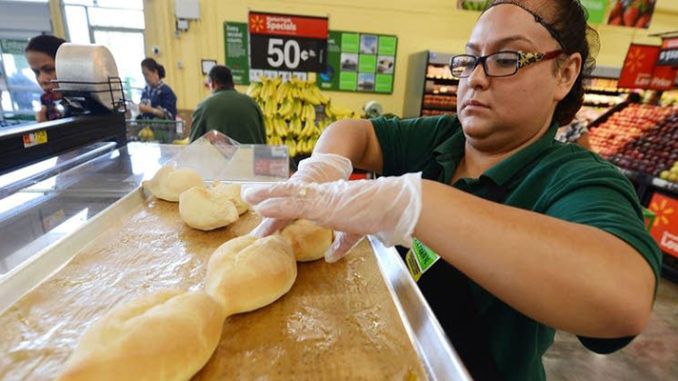
by and
The Trump White House and Washington policymakers have touted the tight labor market as the main engine driving gains for the working class, but a Washington Post analysis of Labor Department data suggests that paychecks also grew because of a nationwide movement of rising minimum wages in various states and cities over the past couple of years.
Last week, Gary Cohn, former director of President Trump’s National Economic Council, and Kevin Hassett, former chairman of the Trump’s Council of Economic Advisers, wrote a Wall Street Journal op-ed making the case that Trump’s tax cuts paved the way for rising wages for those in lower-paying jobs.
The November unemployment rate was at its lowest since 1969, at 3.5 percent, according to the Labor Department. Competition for workers at all levels, including low-skilled ones, has intensified. But can it really be a coincidence that the boom in wage growth came at a time when around half the states raised their minimum wage? The data suggests that changes to minimum wage laws also played a role.
In the past week, minimum wages have risen in more than 20 states. Many of them are the result of increases that have been implemented in phases over the past few years, or indexed to inflation. Nearly 7 million workers began 2020 with higher wages, according to the Economic Policy Institute, a left-leaning think tank. This week, New Mexico’s wage floor rose from $7.50 an hour to $9, and Washington state’s rose from $12 to $13.50.
Ernie Tedeschi, head of fiscal analysis at Evercore ISI, calculates that state and local policies pushed the country’s “effective” minimum wage rate to its highest rate ever. Tedeschi finds that an average hour of work subject to a minimum wage was about $11.80 an hour in 2019.
A hot labor market helps, but policies that increase the minimum wage are a “really meaningful part of wage growth for low-wage workers,” said Heidi Shierholz, senior economist at the Economic Policy Institute. “That is absolutely, undeniably true.”
Sure enough, the data suggests that people are not just getting paid more because there is more competition for their services. They are getting paid more because laws now require employers to pay them more.
But when you break those low-wage workers into two groups — those who live in states that have raised their minimum wage in the past three years and those in states that have not — the relationship between policy changes and wage gains becomes clearer. Our analysis of Labor Department data shows that before 2016, wages for lower-paid workers rose across the country at more or less the same pace. In 2017, things began to change. Wage growth in states that increased minimum wages began to accelerate.
Over the past year, paychecks for those in bottom 25 percent of the workforce grew almost 1.5 times as fast as those in states where the minimum wage did not budge. Also, workers age 20 and under fare better in states that raised the minimum wage.
To be sure, the wage increases appear concentrated among those who already have a job. That is a group that typically sees the benefits of minimum wage increases first, research has shown. Also, the data does not show the same kind of accelerated benefits for the growing group of workers who are returning to the workforce after waiting on the sidelines for years.
But the influence of a higher minimum wage on low-wage workers is clear, economists say, even if its magnitude can be hard to measure.
“This suggests that the minimum wage has been a factor, though not the primary factor, behind wage growth at the lower end,” said economist Jeffrey Clemens of the University of California at San Diego, who has been more skeptical of the benefits of a higher minimum wage than some of his peers.
By contrast, wages for most workers do not reflect the same pattern. The other 75 percent of the workforce didn’t see pay hikes to the same degree, even in states where minimum wage increased. That reinforces the idea that rising minimum wages are the main reason that low-wage workers are doing better, as opposed to other forces.
“There are some very strong signals that minimum wages are in fact actually raising wages more for people at the bottom than you would expect just on tightening labor markets,” said the Economic Policy Institute’s Ben Zipperer, whose research on the effects of minimum wages has been widely cited.
And these paycheck pops for the poor are not happening only in urban, coastal enclaves. Consider Arkansas, where last year voters approved a plan to steadily hike the state minimum wage until it hits $11 an hour in 2021. Over the past three months, the state’s workers have seen the fastest wage growth of any state in the union.
And the move was popular. In 2018, the Arkansas ballot initiative to raise the minimum wage won 68 percent of the vote in an election where Republicans swept all the other key races. The wage hike was controversial, as Arkansas business owners worried about the labor costs associated with paying employees more and warned of job losses.
But that didn’t happen. In November, the Arkansas unemployment rate was 3.6 percent, down from 3.7 percent a year earlier.
Liberals in that state celebrated the success of the law, which first went into effect last year.
“To the extent we are seeing wage growth at the bottom, I would attribute that to state and local policies,” said Bruno Showers, senior policy analyst at Arkansas Advocates for Children and Families.
Arkansas’ minimum wage jumped a second time Wednesday, going to $10 an hour from $9.25 in 2019. That means the state′s low-wage workers, along with millions of others across the country, can count on a decent raise in 2020.

